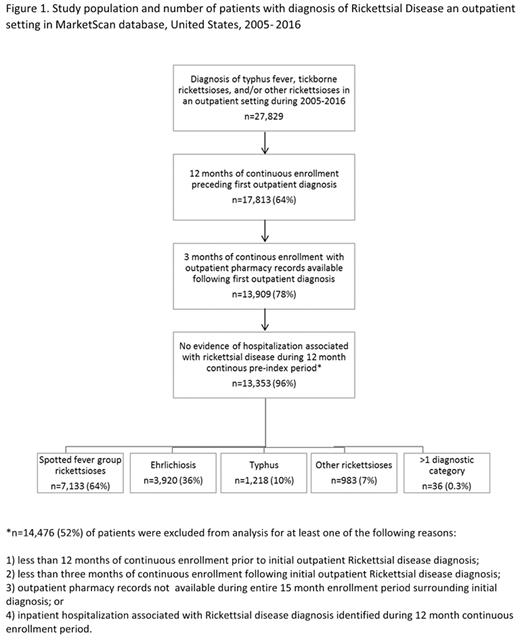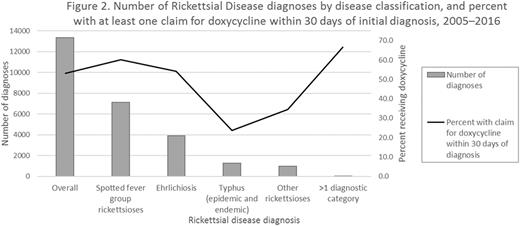-
PDF
- Split View
-
Views
-
Cite
Cite
Alison Binder, Amy E Peterson, Paige Armstrong, 663. Characteristics, Treatment Patterns, and Outcomes of Outpatients With Rickettsial Diseases in a Large, Commercially Insured Population: United States, 2005–2016, Open Forum Infectious Diseases, Volume 5, Issue suppl_1, November 2018, Pages S239–S240, https://doi.org/10.1093/ofid/ofy210.670
Close - Share Icon Share
Abstract
Rickettsial diseases (RD) include Spotted Fever Group (SFG) Rickettsiosis, Ehrlichiosis, Anaplasmosis, Typhus Group (TG) and Rickettsialpox, among others. Doxycycline is the treatment of choice in all age groups; early treatment based on clinical diagnosis is important to prevent severe and fatal outcomes. SFG, Ehrlichiosis, and Anaplasmosis are nationally notifiable in the United States, but data on treatment patterns are not collected.
We conducted a retrospective analysis using Truven Health MarketScan® Commercial Claims and Encounters databases. We included any individual with an outpatient claim using an ICD-9/10-CM code for RD, who had one-year continuous pre- and 3 months post-diagnosis enrollment and pharmaceutical claim data. The first outpatient record with RD was considered the incident diagnosis, and those with an RD hospitalization in the prior 1 year were excluded. Epidemiologic characteristics, treatment patterns, and outcomes were summarized.
13,353 individuals were included; median age was 45 years (IQR: 28–55 years), 2,045 (15%) were under 18 years of age, and 51% were male. The most common diagnosis was SFG (7,133; 50%), followed by Ehrlichiosis (3,920; 30%), and Typhus (1,281; 10%); 36 individuals had >1 diagnosis. Over half (7,075; 53%) received doxycycline within 30 of the index date; of these, 3,634 (51%) received it within 14 days. The majority (5,369; 86%) were treated for at least 10 days at the recommended dose. The proportion with a pharmaceutical claim for doxycycline varied considerably across diagnoses and ranged from 24% for TG to 60% for SFG Rickettsiosis. Among the 6,278 (47%) without a claim for doxycycline, 2,185 (35%) were prescribed another antibiotic; 4,093 (28%) were not prescribed any antibiotic. Hospitalization within 30 days of the incident diagnosis was infrequent (149, 1.1%), and the majority were due to either SFR (40%) or ehrlichiosis (37%). No in-hospital deaths were recorded.
RD continues to be an important cause of disease in the outpatient population, but providers are still only prescribing the recommended treatment to about half of those in whom they suspect the disease. Continued education and increased awareness is critical to prevent severe outcomes from RD.


All authors: No reported disclosures.
Session: 66. Public Health: Epidemiology and Outbreaks
Thursday, October 4, 2018: 12:30 PM
- antibiotics
- doxycycline
- select the dosage, dosage form or route of administration
- endemic typhus
- enteric fever
- bovine anaplasmosis
- disclosure
- ehrlichiosis
- fatal outcome
- hospital mortality
- outpatients
- rickettsia infections
- scrub typhus
- typhus, epidemic louse-borne
- diagnosis
- pharmacy (field)
- rickettsial pox
- international classification of diseases
- spotted fevers
- prescribing behavior
- clinical diagnosis





Comments